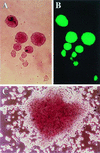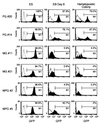Lentivirus vector gene expression during ES cell-derived hematopoietic development in vitro
- PMID: 11044122
- PMCID: PMC110952
- DOI: 10.1128/jvi.74.22.10778-10784.2000
Lentivirus vector gene expression during ES cell-derived hematopoietic development in vitro
Abstract
The murine embryonal stem (ES) cell virus (MESV) can express transgenes from the long terminal repeat (LTR) promoter/enhancer in undifferentiated ES cells, but expression is turned off upon differentiation to embryoid bodies (EBs) and hematopoietic cells in vitro. We examined whether a human immunodeficiency virus type 1-based lentivirus vector pseudotyped with the vesicular stomatitis virus G protein (VSV-G) could transduce ES cells efficiently and express the green fluorescent protein (GFP) transgene from an internal phosphoglycerate kinase (PGK) promoter throughout development to hematopoietic cells in vitro. An oncoretrovirus vector containing the MESV LTR and the GFP gene was used for comparison. Fluorescence-activated cell sorting analysis of transduced CCE ES cells showed 99.8 and 86.7% GPF-expressing ES cells in the VSV-G-pseudotyped lentivirus (multiplicity of infection [MOI] = 59)- and oncoretrovirus (MOI = 590)-transduced cells, respectively. Therefore, VSV-G pseudotyping of lentiviral and oncoretrovirus vectors leads to efficient transduction of ES cells. Lentivirus vector integration was verified in the ES cell colonies by Southern blot analysis. When the transduced ES cells were differentiated in vitro, expression from the oncoretrovirus LTR was severely reduced or extinct in day 6 EBs and ES cell-derived hematopoietic colonies. In contrast, many lentivirus-transduced colonies, expressing the GFP gene in the undifferentiated state, continued to express the transgene throughout in vitro development to EBs at day 6, and many continued to express in cells derived from hematopoietic colonies. This experimental system can be used to analyze lentivirus vector design for optimal expression in hematopoietic cells and for gain-of-function experiments during ES cell development in vitro.
Figures





References
-
- Barklis E, Mulligan R C, Jaenisch R. Chromosomal position or virus mutation permits retrovirus expression in embryonal carcinoma cells. Cell. 1986;47:391–399. - PubMed
-
- Bartz S R, Vodicka M A. Production of high-titer human immunodeficiency virus type 1 pseudotyped with vesicular somatitis virus glycoprotein. Methods. 1997;12:337–342. - PubMed
-
- Becker K G, Jedlicka P, Templeton N S, Loitta L, Ozato K. Characterization of hUCRBP(YY1,NF-E1,δ): a transcription factor that binds to the regulatory regions of many viral and cellular genes. Gene. 1994;150:259–266. - PubMed
Publication types
MeSH terms
Substances
LinkOut - more resources
Full Text Sources
Other Literature Sources
Medical

